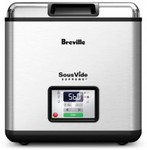Unreal price on the Breville BSV600 Sous Vide Supreme! (so good I couldn't resist!)
A previous ozbargain post has listed this as a great price at $399.
Breville Australia currently lists the RRP as $499
Delivery is quite reasonable in Melbourne, $6.95, and you can pick it up too if you live near Brooklyn, Vic.
The deal is only valid until the end of this month, not sure how much stock they have.
edit: Note that it's also available at Stan Cash (cheaper shipping for WA buyers, thanks rakeem)





In case I'm not the only one who didn't know what this thing is, I found a youtube review:
https://www.youtube.com/watch?v=c40oNPDOL4E
Quick Summary: Sous Vide means "Under Vacuum" in French. This is for cooking vacuum sealed foods in heated water :)